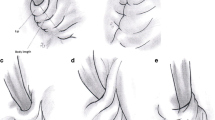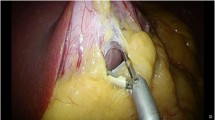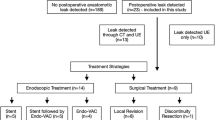Abstract
Background
Objective assessment of postfundoplication anatomy is of utmost importance especially if reoperative intervention is being planned. There is a lack of uniformity in the description of endoscopic findings in these patients. The purpose of this study was to propose a classification for standardized endoscopic reporting of postfundoplication anatomy.
Methods
After institutional review board approval, preoperative endoscopic findings of patients who underwent reoperative intervention from 1992 to 2011 were reviewed and classified. The classification included four factors: E (distance of GEJ to crus), S (amount of gastric tissue between the GEJ and fundoplication), F (fundoplication configuration), and P (paraesophageal hernia).
Results
The endoscopic findings of 310 patients who underwent reoperative antireflux surgery were classified using the newly proposed classification model. A significant increase in the number of procedures was noted over the years. There was no change in presenting symptoms and patterns of failure over the years. The classification model was easily applicable to previous endoscopy reports. There was good symptom association with our classification model.
Discussion
An endoscopic anatomical classification is proposed for description of failed fundoplication. With this classification, we hope to fill the gap in developing a uniform classification of failed fundoplications. Further studies addressing widespread applicability and outcome analysis are needed.

Similar content being viewed by others
References
Jay AP, Watson DI (2010) Changing work patterns for benign upper gastrointestinal and biliary disease: 1994–2007. ANZ J Surg 80(7–8):519–525
Finks JF, Wei Y, Birkmeyer JD (2006) The rise and fall of antireflux surgery in the United States. Surg Endosc 20(11):1698–1701
Spechler SJ (2004) The management of patients who have “failed” antireflux surgery. Am J Gastroenterol 99(3):552–561
Juhasz A, Sundaram A, Hoshino M, Lee TH, Mittal SK (2011) Endoscopic assessment of failed fundoplication—a case for standardization. Surg Endosc 25(12):3761–3766
Broeders JA, Rijnhart-de Jong HG, Draaisma WA, Bredenoord AJ, Smout AJ, Gooszen HG (2009) Ten-year outcome of laparoscopic and conventional Nissen fundoplication: randomized clinical trial. Ann Surg 250(5):698–706
Galvani C, Fisichella PM, Gorodner MV, Perretta S, Patti MG (2003) Symptoms are a poor indicator of reflux status after fundoplication for gastroesophageal reflux disease: role of esophageal functions tests. Arch Surg 138(5):514–518
Furnee EJ, Draaisma WA, Broeders IA, Gooszen HG (2009) Surgical reintervention after failed antireflux surgery: a systematic review of the literature. J Gastrointest Surg 13:1539–1549
Khajanchee YS, O’Roukre R, Cassera MA, Gatta P, Hansen PD, Swanström LL (2007) Laparoscopic reintervention for failed antireflux surgery. Arch Surg 142(8):785–792
Hunter JG, Smith CD, Braunum GD, Waring JP, Trus TL, Cornwell M, Galloway K (1999) Laparoscopic fundoplication failures: patterns of failure and response to fundoplication revision. Ann Surg 230(4):595–606
Jobe BA, Kahrilas PJ, Vernon AH, Sandone C, Gopal DV, Swanstrom LL, Aye RW, Hill LD, Hunter JG (2004) Endoscopic appraisal of the gastroesophageal valve after antireflux surgery. Am J Gastroenterol 99(2):233–243
Iqbal A, Awad Z, Simkins J, Shah R, Haider M, Salinas V, Turaga K, Karu A, Mittal SK, Filipi CJ (2006) Repair of 104 failed anti-reflux operations. Ann Surg 244(1):42–51
Legner A, Tsuboi K, Bathla L, Lee TH, Morrow LE, Mittal SK (2011) Reoperative antireflux surgery for dysphagia. Surg Endosc 25(4):1160–1167
Juhasz A, Sundaram A, Hoshino M, Lee TH, Mittal SK (2012) Outcomes of surgical management of symptomatic large recurrent hiatus hernia. Surg Endosc 26(6):1501–1508
Hoshino M, Srinivasan A, Mittal SK (2012) High-resolution manometry patterns of lower esophageal sphincter complex in symptomatic post-fundoplication patients. J Gastrointest Surg 16(4):705–714
Mittal SK, Legner A, Tsuboi K, Juhasz A, Bathla L, Lee TH (2012) Roux-en-Y reconstruction is superior to redo fundoplication in a subset of patients with failed anti-reflux surgery. Surg Endosc. doi:10.1007/s00464-012-2537-4
Disclosures
Drs. Mittal, Juhasz, Ramanan, Hoshino, Lee, and Filipi have no conflict of interest or financial ties to disclose.
Author information
Authors and Affiliations
Corresponding author
Rights and permissions
About this article
Cite this article
Mittal, S.K., Juhasz, A., Ramanan, B. et al. A proposed classification for uniform endoscopic description of surgical fundoplication. Surg Endosc 28, 1103–1109 (2014). https://doi.org/10.1007/s00464-013-3282-z
Received:
Accepted:
Published:
Issue Date:
DOI: https://doi.org/10.1007/s00464-013-3282-z




